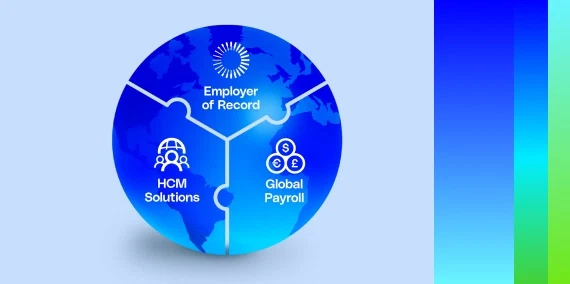Charles Ferguson, General Manager – APAC at G-P, and John Antos, Vice President Strategy, Asia Pacific & Global Payroll at ADP, took center stage at the busy HR Tech Festival Asia to share their insights on how inspired leadership can unlock opportunities in today’s challenging business environment.
Whether you couldn’t make it to their session, “Leading at Work: Thriving in the Face of Global Headwinds,” or you could use a refresher of the content covered, we’ve gathered the key discussion takeaways we hope you can apply to your own company.
1. Balancing the changing power dynamics in organizations will help improve people management.
It’s difficult to illustrate just how much business has changed in the last couple of years. For most companies, day-to-day operations have undergone fundamental shifts, especially in terms of people management – from the way people work to the power dynamics within organizations. And while a poll question during the talk revealed how most of the audience believed that employees are no longer in the driver’s seat, that was not the case just a year ago.
According to Ferguson, in the decades leading up to the pandemic, it was an employer-led labor market. Antos agreed, adding that the pandemic gave everyone “a chance to change … and a lot of people took advantage of that change. It felt like employees had the upper hand.” However, he also acknowledged how today’s market has pivoted back in favor of the employer. Companies, now having the people they need, are prioritizing quality hires over numbers.
While the pendulum has swung back, the ongoing market volatility suggests that we are headed towards a more balanced and stable position, wherein all sides are favored.
2. Promoting remote work can boost organizational morale.
Ferguson identified one of the most prominent sources of tension between leadership and employees as the attitude towards remote work. Antos agreed, emphasizing that, according to ADP’s research, the challenge for leaders is to manage their workforce equally. “It takes different management skills to manage somebody that’s remote,” he said. Antos recommended implementing targeted training to help bridge the gap.
In the same light, Ferguson advised business leaders to “step back and reevaluate the values of your business.” He added that business values from three and a half years ago are fundamentally different than what are necessary today. Thus, it calls for agile leadership to successfully adapt to these changing work norms.
Ferguson cited G-P as a remote-first business, living out its mission of helping companies unlock the power of the everywhere workforce through its own work culture – where employees can work fully remotely.
3. Building global teams can help companies capitalize on flexibility and wider talent pools.
A major change in business that has accelerated in the last couple of years is companies’ ability to operate with teams from different parts of the world, particularly in varying time zones. Employment technologies have not only made hiring and managing global teams possible, but simpler. Antos sees this as an opportunity, and he challenged leaders to incorporate the concept into their business.
This arrangement is beneficial for democratizing opportunities for workforces around the world, while also providing more freedom and flexibility, not just to employees, but to leaders as well.
Antos celebrated the concept, explaining, “Now, you can move where you want to. Companies allow you to do that. Even if you stay in Singapore, you can manage a team in Europe.”
4. Identifying next leaders will secure future business development.
A cornerstone of leadership is being able to identify and mold the next generation of leaders.
Ferguson believes that companies should look for more than core competencies when hiring. He alluded to the DICE model when evaluating characteristics of future leaders – determination, the ability to derive insights and passion, curiosity, and the ability to express empathy and engage people.
Antos added that companies should be looking for people who are “already leaders” – people who project leadership qualities. He dispelled the notion that a person has to be a people manager in order to become a leader.
Antos further noted that leaders should also be able to share their abilities and adapt to shifting circumstances. He said to become a leader “is to become a mentor and to help translate that knowledge and your skills, and help build skills that are changing because all the organizations and the world around us are changing very quickly.”
5. Turning economic disruptions into business opportunities will bolster growth.
Despite the challenges that may come with economic disruptions, in today’s business landscape, they can offer companies a chance to further their growth trajectories.
Ferguson encouraged leaders to “view all of the disruptions and changes that are wildly out of our control as opportunities,” as these changes will improve jobs and make businesses future-proof. He cited artificial intelligence as an example of a major disruption that companies can capitalize on with proper upskilling.
Antos agreed, adding how he doesn’t see the circumstances of business today changing in the foreseeable future. He touched on examples of such changes, citing how payroll data analytics are now being leveraged in talent acquisition and how skills like data visualization, that were not previously in demand before, are now highly sought after. He challenged leaders to embrace the changes and to not “be afraid to try and experiment with your teams.”
The human element in HR should not be overlooked, either. According to Ferguson, several operational models that proliferated during the pandemic have improved diversity in the workforce.
“Diversity has been proven time and time again to future-proof your business — to increase your competitive differentiation in the marketplace,” he said. Antos agreed with this human-centric view while recalling ADP’s tagline, “always designing for people.”
Leading amid disruptions
Shifting market dynamics, expansion of remote work, the rise of global employment, and all of today’s disruptions can serve as gateways to opportunities with the right vision and guidance. Leadership during these evolving times is key in ensuring long-term business success, especially when leaders are careful not to lose sight of the people behind people management.
Discover how G-P and ADP can help your company grow internationally. For more expert insights on fostering leadership and achieving global growth, visit our knowledge base and join our upcoming events.







